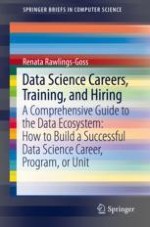This book is an information packed overview of how to structure a data science career, a data science degree program, and how to hire a data science team, including resources and insights from the authors experience with national and international large-scale data projects as well as industry, academic and government partnerships, education, and workforce.
Outlined here are tips and insights into navigating the data ecosystem as it currently stands, including career skills, current training programs, as well as practical hiring help and resources. Also, threaded through the book is the outline of a data ecosystem, as it could ultimately emerge, and how career seekers, training programs, and hiring managers can steer their careers, degree programs, and organizations to align with the broader future of data science. Instead of riding the current wave, the author ultimately seeks to help professionals, programs, and organizations alike prepare a sustainable plan for growth in this ever-changing world of data.
The book is divided into three sections, the first “Building Data Careers”, is from the perspective of a potential career seeker interested in a career in data, the second “Building Data Programs” is from the perspective of a newly forming data science degree or training program, and the third “Building Data Talent and Workforce” is from the perspective of a Data and Analytics Hiring Manager. Each is a detailed introduction to the topic with practical steps and professional recommendations.
The reason for presenting the book from different points of view is that, in the fast-paced data landscape, it is helpful to each group to more thoroughly understand the desires and challenges of the other. It will, for example, help the career seekers to understand best practices for hiring managers to better position themselves for jobs. It will be invaluable for data training programs to gain the perspective of career seekers, who they want to help and attract as students. Also, hiring managers will not only need data talent to hire, but workforce pipelines that can only come from partnerships with universities, data training programs, and educational experts. The interplay gives a broader perspective from which to build.
